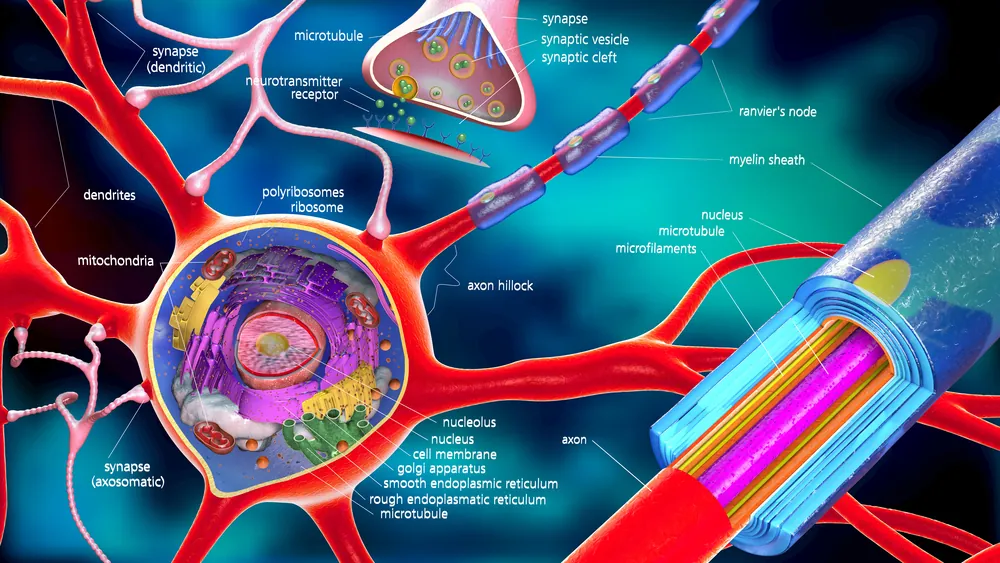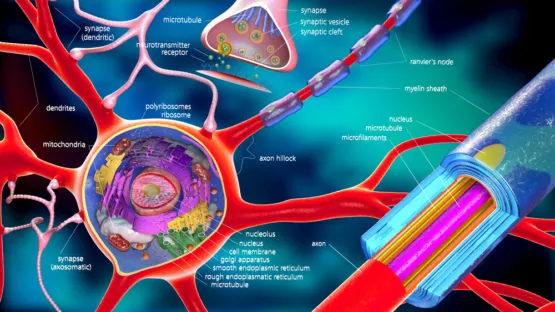An open-access paper published in Nature Communications sheds light on how an accumulation of α-synuclein protein in brain cells contributes to causing Parkinson’s disease. In particular, the researchers discovered how clumps of the protein damage important proteins on mitochondrial surfaces, leading to impaired energy production, swelling and bursting of the mitochondria themselves, and, ultimately, cell death [1].
Study abstract
Protein aggregation causes α-synuclein to switch from its physiological role to a pathological toxic gain of function. Under physiological conditions, monomeric α-synuclein improves ATP synthase efficiency. Here, we report that aggregation of monomers generates beta sheet-rich oligomers that localise to the mitochondria in close proximity to several mitochondrial proteins including ATP synthase. Oligomeric α-synuclein impairs complex I-dependent respiration. Oligomers induce selective oxidation of the ATP synthase beta subunit and mitochondrial lipid peroxidation. These oxidation events increase the probability of permeability transition pore (PTP) opening, triggering mitochondrial swelling, and ultimately cell death. Notably, inhibition of oligomer-induced oxidation prevents the pathological induction of PTP. Inducible pluripotent stem cells (iPSC)-derived neurons bearing SNCA triplication, generate α-synuclein aggregates that interact with the ATP synthase and induce PTP opening, leading to neuronal death. This study shows how the transition of α-synuclein from its monomeric to oligomeric structure alters its functional consequences in Parkinson’s disease.
Parkinson’s disease and the Hallmarks
Parkinson’s disease (PD) is a severely debilitating neural disease whose incidence rises with age. It impairs sufferers’ independence by reducing their mobility, stiffening their muscles, and causing tremors. It can either be familial or sporadic: some people have a genetic predisposition to the disease, but other people can get it without inheriting this predisposition. We have known for a while that both mitochondrial dysfunction and loss of proteostasis, two of the Hallmarks of Aging, are implicated in both versions of the disease, and this research confirms that fact. The accumulation of α-synuclein protein leads to the death of neural cells, but until recently, it wasn’t clear how this happened. A study resulting from a collaboration between scientists at the Francis Crick Institute, UCL, the UK Dementia Research Institute at the universities of Cambridge and Edinburgh, New York University, and other institutions provides new insight on this key question; as the study title says, the culprit is an interaction between α-synuclein clumps and ATP synthase.
What is α-synuclein?
α-synuclein is a protein found primarily in brain cells, though it is also found in smaller amounts in other types of tissue. Its exact function is currently unknown, but some possible functions have been suggested—for example, it might be involved in regulating the release of the neurotransmitter dopamine.
What is ATP synthase?
ATP synthase is an enzyme that makes the production of ATP, the so-called “energy currency of cells”, possible. ATP (adenosine triphosphate) is synthesized from ADP (adenosine diphosphate) and inorganic phosphate, but the reaction is energetically unfavorable—in other words, it cannot happen spontaneously, and it rather tends to happen the other way around, breaking down ATP into phosphate and ADP. ATP synthase catalyzes this reaction and allows the synthesis of ATP in mitochondria; ATP is then used to power cellular functions.
The study
α-synuclein is known to regulate ATP synthase, thereby improving the efficiency of ATP production, when it is in its monomeric form—that is, when it is not aggregated with other α-synuclein molecules. In this study, the researchers wanted to see if aggregate forms of α-synuclein made any difference in this respect.
They investigated this question in both rat brain cells and human brain cells. To obtain the latter, they sampled skin cells from patients carrying a mutation in the gene encoding α-synuclein that leads to early-onset PD; then, they induced the skin cells to transform into pluripotent stem cells, thereby obtaining so-called induced pluripotent stem cells, or iPSCs, and, finally, they made the iPSCs differentiate into neurons.
They observed that, unlike the monomeric form, clumps of α-synuclein oxidized both ATP synthase and mitochondrial membranes; this, in turn, induced a decrease in the production of ATP, and thus the overall energetic efficiency of the cells, and damaged the surfaces of mitochondria, increasing the odds that a protein called the permeability transition pore (PTP) might open and make the mitochondria swell and burst, eventually leading to cell death. The researchers also observed that inhibiting the oxidation induced by clumped α-synuclein prevents PTP opening.
Conclusion
The study provides an explanation of why the accumulation of α-synuclein aggregates is harmful and how it may lead to PD. The researchers hope that this may pave the way to new drugs that target the aggregated form of α-synuclein while leaving alone the healthy, monomeric one.
Literature
[1] Ludtmann, M. H., Angelova, P. R., Horrocks, M. H., Choi, M. L., Rodrigues, M., Baev, A. Y., … & Al-Menhali, A. S. (2018). α-synuclein oligomers interact with ATP synthase and open the permeability transition pore in Parkinson’s disease. Nature communications, 9(1), 2293.




